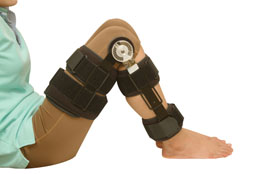Stress fractures are becoming an increasing nuisance in sports medicine, especially among runners. Excessive and repetitive strain on the bones develops a tiny hairline crack in the bone causing stress fractures. Micro damage to the bone caused by a hairline fracture can eventually become chronic if not treated.

In 1855 Briethaupt, a military doctor made the first documentation of stress fractures in soldiers, hence these are also known as 'march fractures.' Stress fractures occur as a result of depressed bone in response to the ground-reaction forces that are usually dissipated during walking, running or jumping. Bones are capable of remodeling when exposed to normal strain and stress. Overuse or excessive loads are the predisposing factors for hairline fractures.
Causes of Stress Fractures
Intrinsic Causes
Most of all stress fractures occur in the legs and foot as they are subjected to maximum weight bearing.
- Foot Structure: Instability and inappropriate weight bearing due to high arched foot increases pressure on leg bones leading to fractures.
- Bone density: Osteopenia and osteoporosis make the bones frail on account of the reduced mineral bone density.
- Muscle system: Weaker muscles or reduced flexibility of muscles increase stress on related bones. Women are more prone to stress fractures as they have lesser bulk of muscle mass compared to men. Lesser muscle girth means low shock absorption.
- Inadequate nutrition: Low intake of calcium and vitamin D. Abnormal eating habits like fasting, binge eating or use of laxatives.
- Medical conditions: Hyperparathyroidism, Osteosarcoma
- Hormonal conditions: Estrogen deficiency, menstrual dysfunction and amenorrhea
- Any coinciding injury can cause reverse compensation by overloading the bones and joints leading to stress fractures.
- Adolescents : Developing bones in teenage is one of the risk factors.
External Causes- Aggressive training program: Rapid increase in duration and intensity of workouts
- Improper footwear: Shoes with faulty cushioning or worn-out shoes cause low shock absorbing capacity
- Training surface: Hard and uneven surfaces
- Medications : Long term use of steroids
- Cigarette smoking
Symptoms of Stress Fractures- Pain at rest or pain increases with activity
- Pain at night
- Pain may be diffuse or spot tenderness
- Swelling
Stress fracture can be seen in an X-ray mostly after 6 weeks of onset of pain. An orthopedic surgeon might suggest CT scan or MRI to confirm diagnosis.
Related Activity/Sports
Site of Stress Fracture
Marching
Metatarsal, calcaneus
Ballet dancing
Tibial shaft, metatarsal bone
Runners
Tibial shaft, patella, femur, sesamoid bones
Rowers
Rib-2nd to 10th
Tennis
Navicular injury
Volleyball
Interarticularis injury
Racquet Sports
Humerus
Gymnastics
Pars interarticularis, Ulna
Aerobics
Fibula
Basketball
Medial malleolus
Treatment of Hairline Fractures- Rest is crucial during the healing period of 6-8 weeks
- Ice packs: Application of ice reduces acute pain and inflammation
- Medications: NSAID's or analgesics as per the degree of pain
- Exercise: Non-weight bearing exercises like swimming for overall fitness
- Shoe Inserts: Walking crutches, braces or supportive orthotics are used
- Surgery: Rarely surgical repair is needed
Prevention of Stress Fractures- Muscle strengthening and stretching exercises to increase flexibility.
- Ensure a nutritious diet rich in vitamins and calcium.
- Gradually increase sports activity or exercise.
- Use of proper sports equipment and shoes.


 In 1855 Briethaupt, a military doctor made the first documentation of stress fractures in soldiers, hence these are also known as 'march fractures.' Stress fractures occur as a result of depressed bone in response to the ground-reaction forces that are usually dissipated during walking, running or jumping. Bones are capable of remodeling when exposed to normal strain and stress. Overuse or excessive loads are the predisposing factors for hairline fractures.
In 1855 Briethaupt, a military doctor made the first documentation of stress fractures in soldiers, hence these are also known as 'march fractures.' Stress fractures occur as a result of depressed bone in response to the ground-reaction forces that are usually dissipated during walking, running or jumping. Bones are capable of remodeling when exposed to normal strain and stress. Overuse or excessive loads are the predisposing factors for hairline fractures.